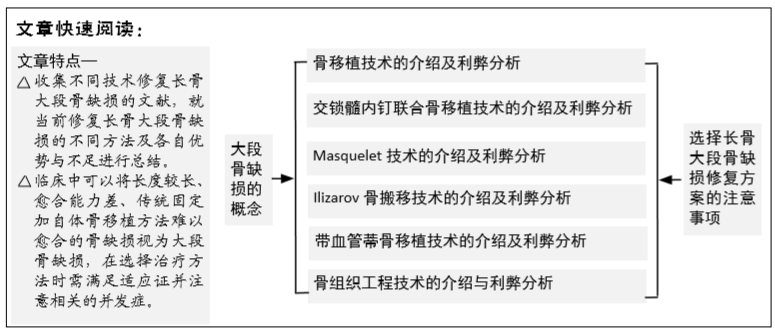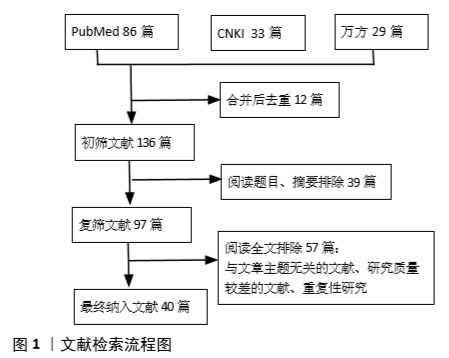[1] SCHMITZ JP, HOLLINGER JO. The critical size defect as an experimental model for craniomandibulofacial nonunions. Clin Orthop Relat Res. 1986; (205):299-308.
[2] MAUFFREY C, BARLOW BT, SMITH W. Management of segmental bone defects. Am Acad Orthop Surg. 2015;23(3):143-153.
[3] RIMONDINI L,NICOLI-ALDINI N,FINI M, et al. In vivo experimental study on bone regeneration in critical bone defects using an injectable biodegradable PLA/PGA copolymer. Oral Surg Oral Med Oral Pathol Oral Radiol Endod. 2005;99(2):148-154.
[4] 胥少汀,葛宝丰,徐印坎.实用骨科学[M].4版.北京:人民军医出版社,2012:1153-1158.
[5] 陈安富,黄凯,周永强.自体骨移植与骨形成蛋白治疗成人长骨骨折不愈合的Meta分析[J].中国骨伤,2020,33(1):87-92.
[6] 杨思敏,王新卫.自体骨移植修复骨缺损的临床研究进展[J].中国疗养医学,2019,28(9):945-948.
[7] 邓伟,巨积辉,李雷,等.胫骨骨不连的原因分析及自体骨移植的治疗进展[J].中国临床解剖学杂志,2019,37(6):726-728.
[8] TARNG YW, LIN KC. Management of bone defects due to infected non-union or chronic osteomyelitis with autologous non-vascularized free fibular grafts. Injury. 2020;51(2):294-300.
[9] 燕斌,于腾波.异体松质骨移植治疗骨肿瘤的有效性分析[J].中华肿瘤防治杂志,2018,25(S2):124-125.
[10] PÉREZ-GONZÁLEZ F, MOLINERO-MOURELLE P, SÁNCHEZ-LABRADOR L,et al. Assessment of clinical outcomes and histomorphometric findings in alveolar ridge augmentation procedures with allogeneic bone block grafts: A systematic review and meta-analysis. Med Oral Patol Oral Cir Bucal. 2020; 25(2):291-298.
[11] 吴浩俊,谭荣雄,何艳霞,等.磷酸钙活性人工骨与自体骨颗粒环抱式植骨治疗四肢骨不连[J].中国临床解剖学杂志, 2020,38(2):202-207.
[12] 邓廉夫,燕宇飞.骨修复材料的研究现状与进展[J].中国修复重建外科杂志,2018,32(7):815-820.
[13] GUERRESCHI F, INAM M, TSIBIDAKIS H,,et al. Spontaneous healing of large cortical defects in long bones: Case reports and review of literature. Injury.2016;47(7):1592-1596.
[14] YANG H, ZHANG Y, HAN Q, et al. Effectiveness of minimally invasive osteotomy Ilizarov technique combined with intramedullary nail for femoral lengthening. Zhongguo Xiu Fu Chong Jian Wai Ke Za Zhi. 2018;32(12): 1524-1529.
[15] LI AB, ZHANG WJ, GUO WJ,et al. Reamed versus unreamed intramedullary nailing for the treatment of femoral fractures: A meta-analysis of prospective randomized controlled trials.Medicine (Baltimore). 2016; 95(29):4248-4256.
[16] XIA L,ZHOU J,ZHANG Y,et al.A meta-analysis of reamed versus unreamed intramedullary nailing for the treatment of closed tibial fractures. Orthopedics. 2014; 37(4): 332-338.
[17] 陈肖松,王长生,程迅生.感染性胫骨骨不连的治疗现状及进展[J].中国骨与关节损伤杂志,2010,25(3):282-284.
[18] 孙锋,严飞,王黎明,等.交锁髓内钉联合自体骨、异体骨及抗生素混合移植治疗胫骨干开放性骨缺损[J].苏州大学学报(医学版), 2007, 27(6):1006-1007.
[19] 余炳田,郑季南,曾丽萍.交锁髓内钉加髂骨植骨治疗胫骨骨缺损的临床应用[J].创伤外科杂志,2017,19(1):52-54.
[20] 刘少华,廖建平,刘璐.交锁髓内钉内固定加植骨治疗长管骨缺损性骨折32例报告[J].江西医学院学报,2002,42(6):79-80.
[21] MASQUELET AC. Muscle reconstruction in reconstructive surgery: soft tissue repair and long bone reconstruction. Langenbecks Arch Surg. 2003; 388(5):344-346.
[22] WANG XH,WEI F,LUO F, et al. Induction of granulation tissue for the secretion of growth factors and the promotion of bone defect repair.J Orthop Surg Res. 2015;10: 147-154.
[23] RAVEN TF, MOGHADDAM A, ERMISCH C, et al. Use of Masquelet technique in treatment of septic and atrophic fracture nonunion. Injury. 2019;50(13): 40-54.
[24] AURÉGAN J,BÉGUÉ T. Induced membrane for treatment of critical sized bone defect: a review of experimental and clinical experiences. Int Orthop. 2014;38(9):1971-1978.
[25] 刘耀辉,薛德挺,高翔.不同类型填充物对Masquelet技术诱导膜的影响[J].中华创伤骨科杂志,2018,20(3):271-276.
[26] BOSEMARK P,PERDIKOURI C,PELKONEN M,et al. The masquelet induced membrane technique with BMP and a synthetic scaffold can heal a rat femoral critical size defect. J Orthop Res. 2015;33(4):488-495.
[27] 林红赛,黄永富,黄元礼,等.基于高效液相色谱法的聚乳酸-羟基乙酸共聚物体外降解产物的测定[J].北京生物医学工程,2017,36(1):62-69.
[28] LIZAROV GA. The tension-stress effect on the genesis and growth of tissues. Part I. The influence of stability of fixation and soft-tissue preservation. Clin Orthop Relat Res. 1989;(238): 249-281.
[29] 王郑钢,张卫,肖湘君,等.骨搬运术治疗胫骨骨折合并骨缺损的临床效果及作用机制[J].山东医药,2018,58(32):61-63.
[30] AKTUGLU K, EROL K, VAHABI A. Ilizarov bone transport and treatment of critical-sized tibial bone defects: a narrative review. J Orthop Traumatol. 2019;20(1):22-25.
[31] 谢伟文,谌业光,张伟才.骨搬运治疗胫骨骨缺损合并软组织缺损的疗效及影响因素[J].局解手术学杂志,2018,27(9):650-654.
[32] TAYLOR GI, MILLER GD, HAM FJ. The free vascularized bone graft. A clinical extension of microvascular techniques. Plast Reconstr Surg. 1975;55(5): 533-544.
[33] QI Y, SUN HT, FAN YG, et al. Do stress fractures induce hypertrophy of the grafted fibula? A report of three cases received free vascularized fibular graft treatment for tibial defects. Chin J Traumatol. 2016;19(3):179-181.
[34] 谭磊,邢志利,姬涛,等.带血运腓骨移植修复下肢恶性肿瘤切除术后骨缺损疗效分析[J].中国修复重建外科杂志, 2019,33(7):850-853.
[35] 陈时高,孙军锁,景斗星,等.带血管蒂的腓骨瓣移植和Ilizarov外固定骨牵引术治疗胫骨骨缺损骨不连的比较[J].骨科, 2016,7(6):412-416.
[36] 赵文博,刘雷.长骨大段骨缺损治疗方式的研究进展[J].现代临床医学, 2014,40(3):230-232+237.
[37] KRAPPINGER D,IRENBERGER A,ZEGG M,et al. Treatment of large posttraumatic tibial bone defects using the Ilizarov method: a subjective outcome assessment. Arch Orthop Trauma Surg.2013;133(6):789-795.
[38] 孙东东,孙明林,高丽兰.生长因子在软骨组织工程中的研究进展[J].中华骨科杂志,2019(10):645-652.
[39] TURNBULL G, CLARKE J, PICARD F, et al. 3D bioactive composite scaffolds for bone tissue engineering. Bioact Mater. 2017;3(3):278-314.
[40] 赵胜利,史本超,高浚淮,等.组织工程骨血管化中种子细胞的研究进展[J].医学综述,2018,24(20):3971-3976. |


